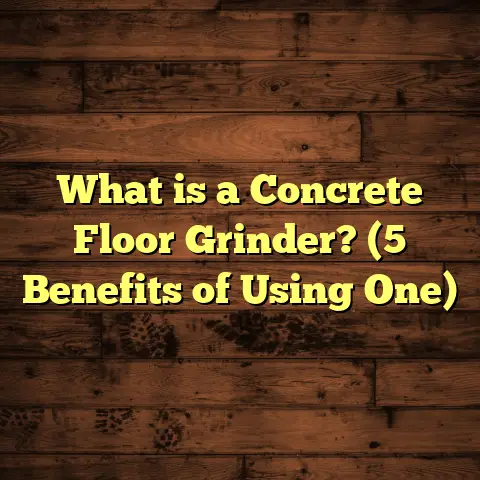What is Better: Porcelain or Ceramic for Tiling? (5 Key Differences!)
Bold Designs and Flooring Choices: Why Porcelain vs. Ceramic?
When I’m talking to clients about flooring, one thing I always notice is how much people want their floors to stand out. Bold designs, striking patterns, or textures that tell a story—these are what make a house feel like a home. But the foundation for any beautiful floor is the material you choose. And if you’re thinking about tiles, which I get asked about all the time, porcelain and ceramic are usually the front runners.
So which one is better? Porcelain or ceramic?
I’ve been in the flooring business for over a decade, helping people create stunning spaces with tiles. I’ve installed both porcelain and ceramic in a variety of settings—from busy kitchens to elegant bathrooms, outdoor patios to commercial spaces. Over time, I’ve learned that the answer isn’t straightforward because each tile type has its own strengths and quirks.
Let me take you through what makes porcelain and ceramic tiles different so you can pick the right one for your project. We’ll cover five key differences that matter most: durability, appearance and design options, installation process, cost considerations, and maintenance.
What is Porcelain and Ceramic Tile?
To start off, it’s helpful to understand what porcelain and ceramic tiles actually are—and why they’re often confused.
Both porcelain and ceramic tiles are made from natural clay that’s baked at high temperatures. But the way they’re made and their composition create distinct qualities.
Ceramic Tile
Ceramic tiles are made from a mixture of white or red clay baked at moderately high temperatures—typically between 1,600°F and 2,100°F (870°C to 1,150°C). After firing, a glaze layer is applied to give them color and protect them from moisture and stains.
Because ceramic clay is less dense and more porous compared to porcelain, these tiles tend to be lighter and softer. This porosity means they absorb more water unless sealed properly.
Ceramic tiles come in two main types: glazed (with a shiny or matte finish) and unglazed (more textured but can absorb stains easily).
Porcelain Tile
Porcelain is technically a subtype of ceramic tile but is made from finer clay mixed with other minerals like sand and feldspar. It’s fired at higher temperatures—between 2,200°F and 2,600°F (1,200°C to 1,430°C)—making it denser and harder than standard ceramic.
This density reduces water absorption dramatically—porcelain tiles absorb less than 0.5% water compared to up to 7% for some ceramics.
Because of its low porosity and strength, porcelain is often used in high-traffic areas and outdoor environments where durability is essential.
1. Durability: Which Tile Holds Up Better?
When you’re choosing flooring materials, durability is usually at the top of your mind. You want a floor that looks great today but will also stand the test of time.
Porcelain’s Strength
Over the years, I’ve noticed porcelain tiles rarely disappoint on this front. Their dense composition makes them tough against scratches, chips, and heavy loads.
One memorable project was a retail store where customers constantly walked in with heavy boots. We used porcelain tiles that mimicked natural stone. After two years, the floor looked almost as good as new despite the heavy traffic.
Data backs this up: porcelain has a hardness rating of 7-8 on the Mohs scale (where diamond is 10). This means it’s resistant to everyday wear and tear that can quickly dull softer materials.
Also important is water resistance. Because porcelain absorbs less than 0.5% water, it doesn’t swell or crack in humid or wet conditions. This makes it ideal for bathrooms, kitchens, or even outdoor patios exposed to rain.
Ceramic Tile Durability
Ceramic tiles are still quite durable but do have some limitations. Their water absorption rate varies between 3-7%, depending on the clay quality and glaze thickness.
They’re more likely to chip or crack under heavy impact or extreme temperature changes if not installed carefully.
I remember installing ceramic tiles in a residential kitchen where a client dropped a heavy cast-iron pan—it left a noticeable chip. If this had been porcelain, the damage might have been avoided due to porcelain’s superior toughness.
Still, ceramic works well in areas with moderate foot traffic like bedrooms, dining rooms, or walls where impact is less frequent.
Summary: Durability in Numbers
| Property | Porcelain Tile | Ceramic Tile |
|---|---|---|
| Water Absorption Rate | < 0.5% | 3-7% |
| Hardness (Mohs scale) | 7-8 | 5-6 |
| Typical Use Cases | High traffic & wet areas | Moderate traffic & dry areas |
If your floor needs to handle heavy use or moisture exposure regularly, porcelain will almost always be the safer bet.
2. Appearance and Design Flexibility
Tiles don’t just need to function; they add character to your space. That’s where design choices come into play.
Ceramic Tiles: Color & Pattern Playground
Ceramic is like an artist’s canvas. Because it’s easier to manufacture with various clays and glazes, ceramic tiles come in hundreds of colors, patterns, sizes, and finishes.
Years ago, I helped a client who wanted bold Moroccan-style patterned tiles for their kitchen backsplash. Ceramic was perfect because vibrant colors like cobalt blue and bright orange showed up beautifully on glazed ceramics.
Ceramic tiles can be glossy or matte, smooth or textured. They can also be hand-painted or machine-printed with intricate designs.
Porcelain Tiles: Realism Meets Modern Tech
Porcelain has caught up fast with design technology thanks to advanced digital printing methods.
Manufacturers can now replicate natural materials like marble, granite, limestone, or even wood grain with impressive realism on porcelain tiles.
I installed wood-look porcelain planks in a modern loft space recently. They looked so authentic that visitors often asked if they were real hardwood floors.
The advantage here is you get the beauty of natural materials combined with porcelain’s durability and water resistance.
Size & Shape Options
Both ceramic and porcelain tiles come in various sizes—from tiny mosaics (1 inch) to large-format slabs (24 inches or more).
Porcelain tends to dominate large-format tile production because its strength allows for thinner yet sturdy panels that create seamless expansive floors with fewer grout lines.
My Take on Design Flexibility
If you want bold colors and artistic patterns that pop—ceramic is your friend.
If you prefer natural stone looks or wood aesthetics with superior durability—porcelain fits better.
Here’s a quick summary:
| Feature | Porcelain | Ceramic |
|---|---|---|
| Color Range | Moderate but realistic | Very broad & vibrant |
| Texture & Finish | Smooth & natural textures | Glossy & patterned options |
| Size Availability | Large format available | Mostly smaller sizes |
3. Installation Differences: What Should You Expect?
Installation can be an overlooked factor but has a big impact on how your floor performs over time.
Handling Porcelain Tiles
Porcelain tiles are heavier due to their density. This means two things: you need stronger adhesive materials designed for porcelain’s weight and sometimes special cutting tools.
I once worked on a commercial kitchen project where we had to rent diamond-tipped blades just to cut through thick porcelain slabs cleanly without cracking them.
Porcelain’s hardness also means it requires more precision during installation—any mistakes can cause chipping or uneven surfaces.
When laying porcelain outdoors or over concrete slabs subject to movement, flexible adhesives and grout are critical to prevent cracking later on due to expansion/contraction.
Ceramic Tile Installation
Ceramic tiles are lighter and easier to cut using standard tile cutters or manual snap cutters.
For DIYers or first-timers tackling a backsplash or bathroom floor, ceramic can be more forgiving because of this ease of handling.
However, ceramic requires proper surface preparation—uneven subfloors can cause cracks due to lower flexibility compared to porcelain.
Grout Choices
Both tile types benefit from quality grout and sealing (especially ceramic) to prevent water infiltration beneath the surface which can cause mold or loosen tiles over time.
I always recommend epoxy grout for porcelain floors because it’s stain-resistant and durable. For ceramic tiles in low-moisture areas, cement-based grout sealed regularly usually works fine.
Installation Cost Differences
Porcelain installation tends to cost about 10-20% more due to heavier materials needing stronger mortar plus longer labor time for precise cutting/fitting.
Ceramic installations are often quicker and cheaper but may require more maintenance if chips/cracks develop sooner.
4. Cost Considerations: Balancing Budget and Quality
Money talks loudest in any project! Understanding upfront costs versus long-term value helps avoid surprises down the road.
Upfront Tile Cost
Ceramic tiles usually come cheaper than porcelain—sometimes by as much as 20-40%. This depends on brand, style complexity, size, and glaze type.
Basic glazed ceramic tiles can start as low as $1-$3 per square foot for common colors/patterns.
Porcelain generally ranges from $3-$10+ per square foot depending on finish and design intricacy (marble-look porcelains tend toward the higher end).
Installation Costs
Because porcelain requires stronger adhesives plus diamond cutting tools and slower installation pace, labor costs tend to be higher by about 10-20%.
For larger projects or commercial settings where durability matters most, this extra cost is often worth it for peace of mind.
Long-Term Value
Here’s something I’ve learned after doing flooring installs for years: spending more upfront on porcelain usually saves money over time because you avoid frequent repairs or replacements caused by ceramic tile damage under heavy use.
For example:
- A ceramic kitchen floor may need grout resealing every few years.
- Chips/cracks might require tile replacements sooner.
- Porcelain floors resist stains/scratches better reducing cleaning/maintenance costs overall.
Using FloorTally for Smart Budgeting
When I’m planning flooring budgets now, I use FloorTally—a handy tool that helps me calculate:
- Material quantities including waste percentages
- Labor costs based on local rates
- Total project cost estimates incorporating different tile types
It makes comparing budgets between ceramic vs. porcelain straightforward since it consolidates all variables in one place without guesswork.
This has saved me loads of time when discussing options with clients who want clear numbers before deciding which tile fits their budget best.
5. Maintenance and Longevity: Keeping Your Floors Looking Fresh
How much effort do you want to put into floor care? This is key when choosing between porcelain and ceramic tiles.
Porcelain Maintenance
Porcelain’s low porosity means it resists stains from everyday spills of coffee, wine, oil—you name it!
Just regular sweeping plus mopping with mild detergent keeps floors sparkling clean without special cleaners or sealants needed frequently.
For outdoor installations exposed to dirt/grime/weathering, porcelain remains tough with minimal fading or damage over years.
Ceramic Maintenance
Ceramic needs a bit more TLC especially if unglazed. Unglazed ceramics absorb stains easily unless sealed properly during installation—and even then sealing needs periodic reapplication every few years depending on wear.
Glazed ceramics are easier but still prone to grout staining if not cleaned promptly after spills or dirt build-up around edges occurs regularly requiring scrubbing/sealing maintenance routines.
Longevity Expectations
Porcelain floors often last decades without significant visible wear—even after heavy foot traffic or pets running around—which I can personally vouch for based on my own home floors installed over 15 years ago still looking great!
Ceramic tends to wear faster in high traffic/moisture zones but still holds up well in moderate use areas if maintained properly.
Real-Life Case Studies & Insights From My Flooring Projects
To give you a clearer picture beyond theory, here are some personal stories from my installations that highlight these differences:
Case Study 1: Porcelain at a Busy Restaurant Entrance
A local restaurant needed durable flooring that could survive constant foot traffic plus occasional spills from drinks/food outside near the doorways.
We chose large-format matte porcelain tiles with slip-resistant texture. After 3 years of daily rush hours plus wet weather exposure during winters, the floor remained chip-free with minimal wear visible—a huge win compared to their previous ceramic tile floor that cracked within a year under similar conditions.
Case Study 2: Ceramic Tiles in a Family Bathroom Remodel
A young couple wanted bright colorful mosaic walls with ceramic tiles in their kids’ bathroom. We picked glazed ceramics for easy cleaning plus fun patterns matching their playful décor style.
While some grout lines stained slightly after heavy use by kids splashing water everywhere (common issue), overall the bathroom looked great after regular cleaning/sealing maintenance—a budget-friendly solution that delivered charm without breaking the bank.
Case Study 3: Outdoor Porcelain Patio Installation
For a friend’s backyard patio project where weather exposure was high—rainfall plus freezes—we installed frost-resistant porcelain pavers with textured finish for slip resistance.
The client was amazed how well these held up through wet winters without cracking or discoloration compared to previous concrete pavers they’d tried before that chipped easily under freeze-thaw cycles.
Quick Tips Based on My Experience
If you’re still wondering which tile suits your needs best, here’s some advice from my years working hands-on:
- For high traffic or wet areas (kitchens, bathrooms, entryways), lean toward porcelain.
- If you want bold colors/patterns on walls or light-use floors, ceramic offers more options at lower cost.
- Prepare for installation costs: expect higher labor/material prices with porcelain.
- Use tools like FloorTally early for accurate budgeting including waste factor calculation.
- Don’t skimp on proper surface prep and quality grout regardless of tile choice—this prevents future problems.
- Think about maintenance commitment: porcelain requires less ongoing care.
- For outdoor use, porcelain’s frost resistance gives it an edge.
- If DIY-ing small projects like backsplashes or accent walls—ceramic might be easier.
- Consider tile thickness—porcelain permits larger format thin tiles while ceramics tend toward smaller sizes.
Wrapping Up My Thoughts Without Saying “In Conclusion”
Choosing between porcelain and ceramic tile isn’t about one being universally better than the other—it depends on what you need for your particular space.
Over thousands of square feet I’ve installed over my career:
- Porcelain shines where durability matters most.
- Ceramic shines when creativity with color/patterns matters most.
And hey—don’t forget budget! Use smart tools like FloorTally so you don’t guess when budgeting but know exactly what you’re paying for materials plus labor costs based on your location and project size.
If you want me to help break down your specific project requirements or share tips for getting perfect tile installation results without headaches—I’m here anytime!
If questions come up while planning your project or you want recommendations on specific products/tools—just ask away!





